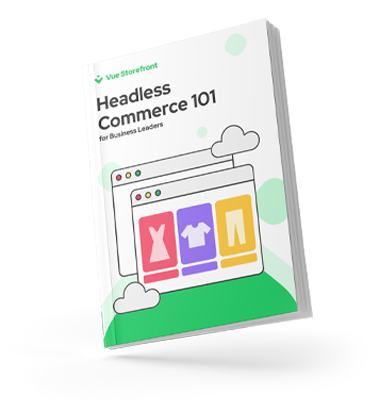7 min
September 19, 2025
What is a Monolithic Application?
In eCommerce application development, all-in-one monolithic applications successfully dominated the industry for decades. However, over the past few years, a significant shift has occurred: Companies have begun implementing composable commerce and the MACH architecture.
Why this sudden change? It turns out that composable commerce can solve most of the problems caused by monolithic architecture, such as slow websites or a poor customer experience.
Today, I will answer the question "what is a monolithic architecture" and explain why they are being replaced more and more frequently. Let's take a closer look at this topic.
Listen to the audio version of this article.
What is a monolithic application?
A monolithic application is an all-in-one system that encompasses multiple eCommerce functionalities in a single place. In the past, monolithic architecture was the only choice for eCommerce businesses. However, with the growth of the eCommerce market and as customers began to expect unique and seamless digital experiences, challenges related to the old monolithic systems began to emerge.
 In monolithic applications, the frontend and backend are strongly coupled in a tightly linked architecture where all components depend on one another. This means that when you want to update one element in the user interface (frontend), it requires changes across the entire eCommerce application. And if something goes wrong, the entire monolithic structure collapses.
In monolithic applications, the frontend and backend are strongly coupled in a tightly linked architecture where all components depend on one another. This means that when you want to update one element in the user interface (frontend), it requires changes across the entire eCommerce application. And if something goes wrong, the entire monolithic structure collapses.
To succeed in the eCommerce industry, continuous evolution is a necessity. However, monolithic architecture still limits marketers' ability to make quick changes to the frontend. This, in turn, impacts the customer experience and leads to a loss of conversions. But the list of disadvantages goes on.
Disadvantages of Monolithic Applications
Now that you know what a monolith is, it's time to discuss its pitfalls. Below you'll find a few key problems presented by traditional legacy solutions.
Decline in speed, SEO, and Google metrics
Poor website performance is one of the biggest disadvantages of monolithic applications. The reason for this is that in a monolithic architecture, all business functions and processes are interwoven, working closely together. A single command from a user causes the entire system to "think," which takes time.
Since the customer experience begins with a lightning-fast page load, a slow website leads to a drop in the conversion rate. A Deloitte study proved that website performance impacts the customer experience more than you think:
In the U.S., latency is the main reason consumers abandon mobile sites, with 10% citing a slow page load as the reason for not making a purchase.
70% of consumers admit that page load speed influences their willingness to shop with retailers.
The probability of a site being rejected increases by 90% when page load time increases from 1s to 5s.
Improving speed by 0.1s translates to 10% more customer spending.
Google Core Web Vitals (CWV) is another significant factor impacting your eCommerce site's performance. Since the 2021 update, Google has been using page and image load times as one of the primary ranking elements for websites. With a monolithic model, it's difficult to implement the changes needed to meet Google's requirements. This, in turn, negatively affects your SEO results.
 Website performance in eCommerce has never been more critical. Unfortunately, with older monolithic software, it seems you are locked into a situation that prevents you from working on this key aspect of your store.
Website performance in eCommerce has never been more critical. Unfortunately, with older monolithic software, it seems you are locked into a situation that prevents you from working on this key aspect of your store.
Negative Customer Experience
The customer experience is one of the most crucial aspects of a company's online presence, and it all happens in the website's presentation layer. However, monolithic technology is unable to provide exceptional customer experiences due to the fact that their store pages are inflexible and cannot be easily updated without a developer's help.
Therefore, updating monolithic eCommerce systems and customizing customer experiences is very time-consuming. Marketers are often completely blocked from making changes to the frontend layer, which deters current and potential customers.
Lack of flexibility
Monolithic applications contain many built-in functionalities within a single system. As such, they are very restrictive and only grow larger with each subsequent update.
You might think that all-in-one systems are quite convenient because they provide most of the necessary functions within a single piece of software. Unfortunately, although most key features are included, they are typically quite basic.
In short, a monolithic architecture prevents you from using best-in-class solutions developed for dedicated tasks (aka microservices). This stops you from innovating and maintaining a competitive advantage.
Furthermore, the process of making changes is demanding and expensive because you have to involve developers every time you want to test new features or update the site. Adding new features is sometimes impossible, even with a development team's involvement.
Ultimately, the extreme complexity and restrictiveness of monolithic architecture is the main brake on scalability. Any attempt to expand operations into new markets involves huge risks, high costs, and the necessity to interfere with the entire system, making the pursuit of growth exceptionally inefficient.
Composable Commerce: The Best Alternative to Monoliths
Composable commerce is a common term for a software architecture that, unlike a tightly coupled monolithic platform, separates the UI (frontend) from the business logic (backend). This gives you the ability to choose the best technologies to build a flexible eCommerce stack. The software communicates via APIs, and individual solutions can be managed without affecting other parts of the system.
Composable architecture allows business teams to control the eCommerce frontend without involving technical teams. This gives them full control and autonomy to achieve their conversion and revenue goals.
The composable approach is aligned with broader trends such as headless commerce and microservices architecture.
Microservices architecture breaks down the entire eCommerce system into separate components and structures them as a set of solutions dedicated to specific functions, such as CMS, search, or payments.
Migrating from a monolith to composable brings numerous benefits that drive Your business
Enables easier scaling and website performance
Supports a mobile-first architecture
Faster and safer updates
Provides advanced personalization
Ensures ultimate flexibility
Additionally, eCommerce stores built on a composable approach give merchants the flexibility they lack when using monolithic software. Thanks to the API-first architecture, they can plug in and unplug individual headless components, allowing for developmental changes and updates without interfering with the rest of their business operations.
Let's take a quick look at the challenges of monolithic architecture that can be easily solved with composable commerce.
 Deciding to adopt composable commerce is a great way to bring success to your eCommerce business, but you'll need the right strategy to move forward. A successful composable journey starts with the storefront, as the frontend drives the customer experience.
Deciding to adopt composable commerce is a great way to bring success to your eCommerce business, but you'll need the right strategy to move forward. A successful composable journey starts with the storefront, as the frontend drives the customer experience.
Want to switch to composable? Start with the frontend.
You don't have to change your entire eCommerce stack to go composable. Since the frontend is where the customer journey happens, let's start your digital transformation by replacing only the presentation layer.
With Alokai (formerly Vue Storefront), you don't have to fully re-platform to gain the flexibility provided by composable commerce. To enhance the customer experience and revenue, build your eCommerce storefront on top of your existing eCommerce platform, using one of the 30+ out-of-the-box integrations.
Alokai is a Frontend as a Service (FEaaS) for composable commerce that delivers custom storefronts at a fraction of the cost and time, with lightning-fast page loads to achieve better conversion rates and higher revenue.
Problems with Monolithic Technology
Pre-defined UX that cannot meet the performance expectations of customers and Google, leading to an increased bounce rate and a drop in the conversion rate.
A tightly coupled frontend and backend reduces the ability to implement best-in-class technologies. This holds back your business when you need to scale and accelerate to meet market demands.
Limited customization capabilities. Merchants have restricted freedom to change pre-defined features or services and replace them with ones that work better. Any UI changes require IT involvement, as they can impact the entire environment.
SEO optimization is complicated, especially for mobile devices. It increases the bounce rate, decreases conversions, and fails the Google Core Web Vitals test.
Slow Time-to-Market due to time-consuming updates and testing phases.
The Alokai Solution
The frontend is designed to meet Google's SEO and UX requirements, leading to increased conversions and customer satisfaction.
You have the freedom to choose from many best-in-class microservices and headless applications to build your eCommerce stack quickly and with the best solutions for your unique needs.
You can easily plug in or unplug headless commerce applications as your business needs change. Headless software is highly configurable and allows your marketing team to update the frontend without IT help.
The Alokai architecture is performance-oriented (including for mobile) with best practices.
Fast Time-to-Market (TTM) benefits with a ready codebase and smaller dev teams, which saves you time and money.




